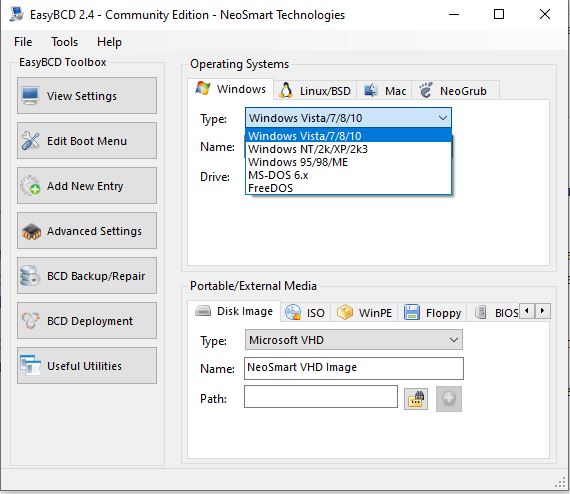
- WINDOWS 10 EASYBCD DRIVER
- WINDOWS 10 EASYBCD FOR WINDOWS 10
- WINDOWS 10 EASYBCD WINDOWS 10
- WINDOWS 10 EASYBCD CODE
- WINDOWS 10 EASYBCD TRIAL
there seems to be a program called BOOTICE from a Chinese developer that apparently could do the job.
WINDOWS 10 EASYBCD TRIAL
Unfortunately, only a trial version of it is now available for free. Even the completely free version of that program would have been sufficient.
WINDOWS 10 EASYBCD CODE
If the Live USB is booting in the legacy BIOS/MBR style, the legacy compatibility firmware code will hide away the interface that is needed by the efibootmgr command.Īlternative tools for fixing problem #3 in the Windows side: If it turns out you have problem #3, you can fix it by using the efibootmgr command in your Kali Live USB - but only if that Live USB is bootable in the UEFI native style. (If you cannot disable Secure Boot, get the -signed version of the first package if available, and also the shim package.) Fixing it would require chrooting to the HDD-based installation and using the package management tools to replace the grub-pc and grub-pc-bin packages with grub-efi-amd64 and grub-efi-amd64-bin respectively. If, on the other hand, there is a sub-directory named i386-pc, you have a traditional BIOS/MBR version of GRUB installed, confirming problem #1. If there is a sub-directory named x86_64-efi, you have an UEFI version of GRUB installed and can definitely exclude problem #1. After mounting the Linux partition(s) on the HDD, go to the directory /usr/lib/grub and list the contents of that directory. The next step would require booting Kali (or some other Linux) from live USB and using it to gain access to the Kali installation on the HDD. Often (but maybe not always) the UEFI BIOS Setup offers a way to do one or both of these things. If problem #2 seems likely, it can be worked around by disabling Secure Boot, or by clearing the Secure Boot Primary Key (PK) variable. If there is no mention of Kali in the output, you can tentatively exclude problem #2 for now - you definitely have at least problem #1 or #3. This will list the boot options registered in NVRAM and the BootOrder settings. The first step for identifying between these cases would be letting the system boot to Windows 10, running a Command Prompt as an Administrator, and using the bcdedit /enum firmware command. Or maybe the firmware implementation will only accept the boot filename of a standard Windows bootloader - that would qualify as a firmware bug. That at least would make this case easier to troubleshoot.)ģ.) The Kali installer may have successfully installed a Secure Boot-capable UEFI bootloader, but failed to register it in the firmware NVRAM. (Other UEFI implementations will output a scary security error message if Secure Boot is enabled and they encounter a bootloader with a missing or invalid Secure Boot signature. If your firmware prefers UEFI-style boot over legacy BIOS style, this bootloader will be completely ineffective, as the firmware just won't load the old-style Master Boot Record at all, once it sees that the Windows UEFI bootloader is in place.Ģ.) The Kali installer may have installed an UEFI version of GRUB, but without the shim.efi that is necessary for Secure Boot - and the Secure Boot implementation of your system's UEFI firmware may silently bypass any bootloader that does not have the necessary Secure Boot signatures, if Secure Boot is enabled. I may also plan on adding Ubuntu in the future, but I have my priorities set on the two versions of Windows.There are several possible things that might be going wrong.ġ.) The Kali installer may have installed a traditional BIOS/MBR-style version of GRUB instead of an UEFI version. I've heard dual booting two versions of Windows is supposed to be easy, is there some simple solution to this? Or have I screwed something up?

WINDOWS 10 EASYBCD WINDOWS 10
I have booted into Windows 10 directly (without the modified Win7 bootloader) and disabled fast boot from the power options, as well as the following commands:īcdedit -set loadoptions DISABLE_INTEGRITY_CHECKSīoth commands ran successfully, but I still get the same digital signing error when I try to boot.
WINDOWS 10 EASYBCD DRIVER
It also will not let me into the F8 advanced boot menu for Win10 so I can disable it from checking driver signtures, throwing the same error as when I try to boot to it normally.
WINDOWS 10 EASYBCD FOR WINDOWS 10
I've installed EasyBCD and made an entry for Windows 10 within the Windows 7 bootloader (Using Windows 7 as my primary OS), however when I try to select Windows 10 from the boot screen, it claims winload.exe is not signed and refuses to boot.īoth Windows 7 and 10 boot properly when I boot directly from their respective hard drives so I know neither OS has been damaged.

So I'm a bit of a Windows 7 fanboy, but I would still like to have Windows 10 as a secondary OS on a separate drive in my PC.


 0 kommentar(er)
0 kommentar(er)
